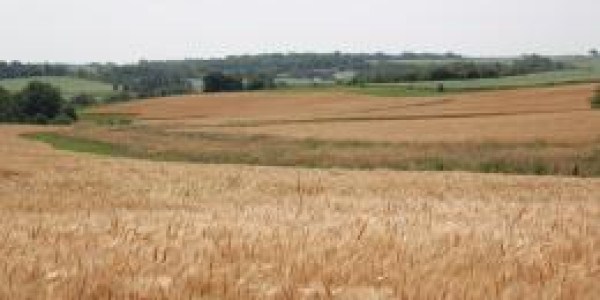By: Amy Mayer Farmland values may begin to fall as commodity crop prices come down. This wheat grew earlier this summer in southwest Iowa. (Amy Mayer/Harvest Public Media) Buy? Sell? Hold? These are the options for cropland owners, whether they currently farm, are retired farmers or never worked the land themselves. How the recent high land values influence that decision obviously depends on a family’s particular circumstances. This connection was explored in our “Changing Lands, Changing Hands” series this summer. David Klein, vice president and managing real estate broker at Soy Captial Ag Servcies in Bloomington, Ill., said the market in Illinois has been stable. And that makes it attractive for buyers he describes as “believers in farmland.” These are people who would rather invest in land than leave their money sitting in a bank. “Right now there’s still a lot of cash being spent,” he said, as opposed to land being purchased with mortgages. Cropland values have gone up every year since 2003, except for 2009. And from 2010 to 2011 in the Northern Plains the USDA estimates the value of farm real estate increased nearly 27 percent. This sustained period of high values prompts some observers and economists to wonder whether farmland is in a bubble that is destined to burst. “Our farmland market here has continued to be pretty stable,” Klein said. He recently tweeted the sale of 240 acres of prime cropland in Edgar County, Ill., when it sold for $12,017 per acre. He said that’s a price right in the range of where Illinois land is selling, with some sales he calls outliers yielding as much as $15,000 to $16,900 per acre. Klein said investors looking to maximize return are more likely to buy larger tracts of land, at lower per-acre prices, while farmers may purchase “the farm next door,” spending more per acre on a smaller overall purchase. “Illinois did not rise as high as Iowa on some of the higher highs,” he said. Last year, a record sale in northwest Iowa captured $21,900 per acre. An article this week in the Wall Street Journal suggested cropland values may be in decline: Cropland values in the Midwest already are losing steam after a surge of nearly 80% in the past four years to an average of $6,980 an acre. The latest appraisals done by farm lender Farm Credit Services of America show that land-value gains slowed in the first six months of the year. Purdue University forecasts a decline in land values in parts of Indiana in the second half of 2013. For now, though, one result of the high land prices that Michael Duffy, an agricultural economist at Iowa State University, has noted is that young people are taking a different view of returning to a family farm business. “Our students here,” he said, “some of them, the 4.0 students, they’re going back to the farm. They see this as an opportunity.” Duffy said that is consistent with other boom periods in land values. Other young people from farming families may choose to hold onto inherited land that they have no intention of farming because they believe they can make money renting it. Duffy expects the data from the 2012 Census of Agriculture is likely to show growth in the percentage of farmland owned by people younger than 35. But, Duffy said, as commodity crop prices come down, land values will, too. “It is less certain the speed they will fall,” Duffy wrote in a paper for Iowa State Extension, “but it appears at this time land values will correct more slowly over a period of time.” So Duffy does not predict a crash like the farm crisis of the 1980s, but the best time to sell may have passed — at least for now. Taylor Scott International
Farmland Values Sway Owners

This entry was posted in Investment, investments, News, Property, Real Estate, Taylor Scott International, TSI, Uk and tagged agriculture, calendar, census, green, investment, investments, javascript, mayer, real estate, values. Bookmark the permalink.







